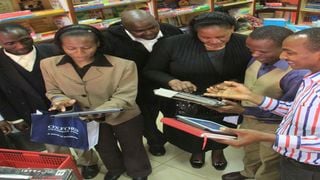
Teachers from Nyeri County admire e-books on Ipads during the launch of e-books and e-learning by e-Kitabu, an online e-book store, at Khimji Devshi Shah bookshop in Nyeri town on October 29, 2014. J
| oseph Kanyi | Nation Media GroupKenya@60
Premium
Digital disruption, govt stranglehold a big threat to six decades of Kenyan publishing
Technology and ownership. These two factors succinctly sum up the impetus behind the tremendous transformation that book publishing has undergone over the past six decades in Kenya.
Before the country attained independence in 1963, publishing activities were limited to efforts by the missionaries to produce educational materials that would help East Africans learn how to read, write and gain basic literacy and numeracy skills.
It is these rudimentary efforts, which utilised basic lithographic processes to produce books that led to the creation of such companies as East African Literature Bureau, which paved the way for the emergence of the government-owned Kenya Literature Bureau.
After independence, the new government initiated efforts to publish educational materials. It was at this time that, in the mid-60s, the majority of the giants of Kenyan publishing came to birth.
First came the multinationals. These were mainly local sales offices of big international publishers such as Longman and Heinemann of the United Kingdom. Pearson, the largest publishing house globally, also had a lengthy presence in the country.
There were also university presses such as Oxford University Press (EA), which is owned by the University of Oxford (UK) and which has been a major player in publishing in Kenya.
Local production
At the dawn of independence, most of these multinational publishers mainly sold books produced by their UK parent companies. They, however, started local production of both educational and cultural works as calls for more culturally relevant reading materials gathered traction.
These firms also had managed to retain top editorial talent, a good example of whom was Jonathan Kariara, an ace editor who worked at OUP Nairobi at a time when most of the editors were European.
The shift to locally produced books was also influenced to a large extent by the clamour for ‘moving the centre’ of literary studies from the so-called European canon (mainly English classics) to African classics.
This campaign reached its apogee in the early 70s, when Ngugi wa Thiong’o, Awuor Anyumba and Sudanese writer and poet Taban Lo Liyong launched the famous push for a paradigm shift in the teaching of literature at the University of Nairobi.
The trio and their supporters are accredited with the pivot towards African cultural works as primary texts for study at Kenyan universities, a fact that accelerated the growth of African writing and publishing.
Again at the dawn of independence, the Kenyan government was keen to produce relevant reading materials for the new nation. That is how state-owned firms such as Jomo Kenyatta Foundation came to be.
In 1965, two British publishers, Cassell and Heinemann, started operations in Nairobi. The two publishers had already made their mark on the African continent, as they were part of the literary publishing success that was the African Writers Series, under which the best literary works to have ever come out of Africa were published.
In 1968, Heinemann East Africa changed its name to Heinemann Kenya, after it became partly locally owned. It was, however, four years later, in 1972, that production of Kenyan cultural works began in earnest. For it was in that year that the publishing house became fully locally owned, prompting it to change its name to East African Educational Publishers (EAEP).
Besides the change of name, it appointed its first Kenyan editor, Henry Chakava, who went on to become the founding chairman of the now vibrant Kenya Publishers Association (KPA).
Advocacy platform
The KPA has over the years become a notable advocacy platform for the publishing industry. KPA also runs the annual Nairobi International Book Fair.
Dr Chakava, who later rose to become managing director and chairman of EAEP, has also written extensively about publishing in Kenya, alongside Ruth Makotsi, Lily Nyariki, and others.
Another notable player was the East African Publishing House (EAPH). The firm came into being when the nascent East African Institute of Social and Cultural Affairs tapped André Deutsch to help them set up a publishing firm in 1964.
Deutsch had been a key player in the African Universities press and was, therefore, a big name in Africa’s literary circles.
In its formative days, EAPH had, as publishing director, John Cato Nottingham, a former colonial district officer who had a remarkable partiality for Kenya’s struggle for freedom.
Nottingham not only helped former Mau Mau writers publish their stories, he was a star witness in a landmark case that saw thousands of Kenyans win compensation in an epic court case against the British government.
Nottingham notably helped General China publish two books on Mau Mau. It was also under his editorship at EAPH that Okot p’Bitek’s oral literature classic, Song of Lawino, was published.
When EAPH went under, Nottingham formed Transafrica Press, with offices on Kimathi Street in Nairobi. TransAfrica Press was behind such publications as journalists Joseph Karimi and Philip Ochieng’s book, The Kenyatta Succession (1980).
From the ashes of EAPH, whose seat of operations was Tanzania, rose such firms as Phoenix Publishers. Phoenix was born after Waruingi Gacheche, the founder, acquired the rights for the primary readers that had been published by EAPH.
Other notable firms that changed hands from big multinationals to fully locally owned publishing firms include Moran Publishers, which initially operated as Macmillan Publishers. The firm was, however, acquired by veteran publisher and book marketer David Muita, who steered it to great heights as a fully owned Kenyan company.
Besides these big outfits, others such as Sasa Sema Publishers sprung up from the vibrant Nairobi literary scene. There was Sasa Sema Publications, established by American Laila Luce, and which was later snapped up by Longhorn Publishers of FT Nyammo. There was Kul graphics, whose black-and-white Pichadithi series was acquired by EAEP.
Comic series
Pichadithi series was in a way a meeting of minds. It was conceptualised Brighton-born cartoonist Terry Hurst who had earlier teamed up with Weekly Review founding editor Hilary Ng’weno to produce the comic series Joe, which was a runaway success in the 70s. In fact, so vibrant was the comic strips business that such leading caricaturists as Paul Kelemba (Maddo), Godfrey Mwapembwa (Gado), the late Frank Odoi - he of the Akokhan and Tonkazan series fame - and John Khamawira (Kham), produced standalone comic publications or newspaper inserts, a case in point being PenKnife.
Away from the comics, EAEP also bought rights for quite a number of the defunct EAPH’s publications. These acquisitions partly explain why EAEP and Nairobi-listed Longhorn, are among the biggest locally owned publishing firms in Nairobi, with a strong presence in the larger Eastern, Central and South Africa.
But perhaps the biggest leap forward in publishing came in the late 90s, when printing firms in Nairobi acquired web offset printers, which could produce more copies using the then cutting-edge computer-to-plate technology. This meant publishers could produce more high-quality books more economically and in a very short period of time.
This technological upgrade, coupled with the fact that the Narc government was reviewing the 8-4-4 curriculum for the first time since its inception in 1984, formed a watershed moment for publishing in Kenya. The curriculum review of 2003-2006 was so huge that, for the first time, publishers started hiring in-house designers, proofreaders, assistant editors and, in some cases, illustrators, photographers and pre-press assistants.
The phenomenal growth of the early 2000s can also be attributed to a favourable government policy. As the Free Primary Education programme of the Kibaki government got underway in 2003, government started sending capitation to public schools. The publishers would market books in staffrooms. The teachers would select the ones they liked and recommend that their principals and head teachers should buy them.
The publishers, however, did not supply to the schools. Each school had a preferred list of book sellers who supplied books to them, in a symbiotic arrangement that created room for publishers and booksellers to grow together.
Many new publishing firms opened their doors during or after this ‘golden’ Kibaki years, including Spotlight Publishers, Mountaintop Publishers and later One Planet Publishers and Queenex Publishers.
One of the unintended consequences of this Kibaki-era boom in the textbooks trade was that in the cut-throat competition for the free education business, most publishers had to scale down on the publication of novels, plays, (autobiographies), travelogues and other cultural productions. As a matter of fact, the industry has since the Kibaki years seen textbooks - for Kenya and the region - crowd out general publishing projects.
The only activity outside coursebooks has been angling for mandatory literary set books for secondary schools, which fetch those who are lucky to have their entries selected by the KICD a tidy sum, albeit with a huge cutback due to the pervasiveness of piracy.
Another reason the cultural works publications have taken the back burner is that since 2016, the government has been asking parents not to buy books, even though school capitation caters only for textbooks.
This arrangement would, however, be destroyed in 2016 when the government went back to buying books and supplying them directly to schools, ostensibly to eliminate collusion between head teachers and rogue booksellers.
For, while the new arrangement lowered the cost of books, it also saw thousands of book sellers close shop. It also led to complaints that quality of reading materials was compromised as teachers no longer had a say in the books they used to teach.
The books were now being selected – and are still selected – by procurement mandarins at the Kenya Institute of Curriculum Development, the technical arm of the Ministry of Education that is headquartered at the intersection of Murang’a Road and Desai Road on the outskirts of Nairobi.
To be sure, the phenomenal growth of the publishing industry has neither been entirely linear nor driven exclusively by the big players.
Around 2010, the stranglehold of the traditional big players on the publishing market was disrupted by the entry of new players who were uncomfortable with the status quo.
This group scoffed at the legacy publishing’s tendency to favour big names, delay and sometimes reject manuscript outright and generally tighten its grip on who got published and when.
Revolution
At the heart of this revolution was Kwani? whose de facto head was Ugandan-born writer-critic Binyavanga Wainaina. Kwani? challenged the aura of exclusivity around publishing and turned tables on traditional notions of publishing.
Their quarterly journal featured everything from graffiti to urban stories penned in slang. Publishers such as Storymoja happened on the scene during this culturally disruptive era when the exchanges in literary pages of mainstream newspapers saw Egara Kabaji, a literary critic, term Tony Mochama, a Kwani? insider and journalist, a literary gangster. Tony went ahead to write a book titled Why I am a Literary Gangsta.
But perhaps a bigger disruption to publishing in Kenya was the advent of digital publishing. With online tools such as Amazon’s Createspeace, Lulu.com and others, writers no longer have to be at the mercy of established publishing firms.
Before the arrival of these online tools, the monopoly of traditional publishers in deciding who joined the literary hall of fame had been challenged by the advent of self-publishing.
People who had given up on waiting for months on end as publishing editors took their time to assess their manuscripts started hiring the services of freelance editors, designers and proofreaders, who prepared their manuscripts for press.
The pivot towards self-publishing was given more impetus by the emergence of print-on-demand (POD) technology, where some printers could produce a limited number of copies for a self-publisher to sell or give out to friends.
While this model was largely not profitable due to the few copies most self-publishers produced and the attendant sales and distribution limitations, it marked a momentous staging post in the historical journey of publishing in Kenya.
As the digital disruption continues turning tables on legacy publishing, it is the stranglehold of the government on publishing that presents the biggest threat to six decades of Kenyan publishing. The situation is made worse by the high cost of printing, with many publishers having to print their books outside the country to cut costs, as there are little or no incentives to promote manufacturing of newsprint locally.
As things stand now, teachers and publishers have little or no say on what happens in the industry, whose activities have, since the inception of the Competence-Based-Curriculum, been controlled by the government.
And while some have been diversifying their product offerings beyond textbooks for schools, most Kenyan publishers today are at the mercy of government capitation for free schooling. Will they ever be able to wean themselves off government funds? Or will they cling on to government funding for survival? Or, tougher still, will they at some point find ways of monetising digital content and survive the digital onslaught? The jury is out.
Mr Munene is an editor at NMG. [email protected]





